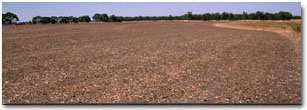Southern Cracking Clay Plains
Landscape
This land system comprises large areas of fairly flat clay plains, predominantly around Neuarpur and the flat to gently undulating plains that occur between the rises or at the edge of lakes. The plains can be quite small in places, almost occurring as drainage depressions between rises. Where they do not represent a sizeable area on the map they were not mapped due to scale restrictions.
 Grey Clay Plains. |
The landscape commonly has gilgai micro-relief due to the high shrink/swell characteristic of the clay.
Native Vegetation
Buloke is the main tree species occurring on the clay plains. The lower depressions show an association between soil surface cracking and Black Box and Lignum Bush.
Soil Types
Grey Vertosols (Site WW10 and Site WW16) are the dominant soil type. These soils are clayey throughout the profile. They seasonally crack due to the high shrink/swell of the clay, causing the distinct gilgai micro-relief. Soil properties can vary across paddocks due to the movement that occurs during wetting and drying cycles (eg. depth to calcium carbonate layers).
Some profiles have a discontinuous bleached A2 horizon that indicates the uneven drainage of the soil.
The surface condition is slightly self-mulching, although once cultivated the surface becomes strongly self-mulching.
There is a large area of this soil type around Neuarpur. Also evident are patches of Sodosols (solodised solonetz and Ferric forms) which are intermixed with redder Vertosols.
Current land Use
Grey Vertosols are commonly cropped for wheat, peas and beans. During the summer months safflower is also sown. Irrigation of white clover for seed production is a common land use when groundwater is available.

The clay plains around Neuarpur are commonly irrigated for white clover seed production.


